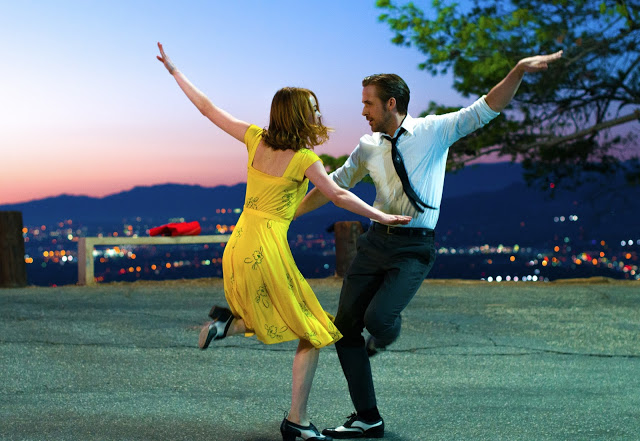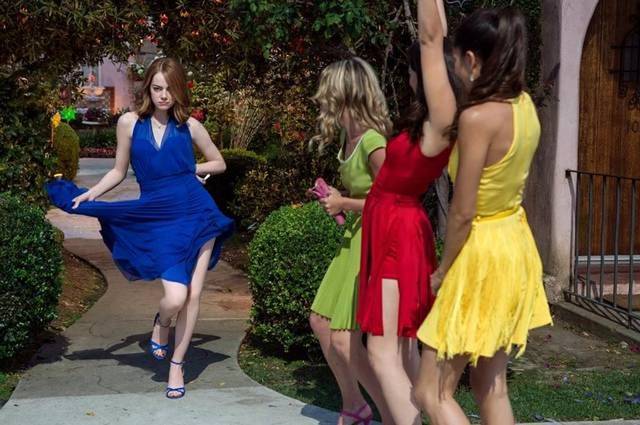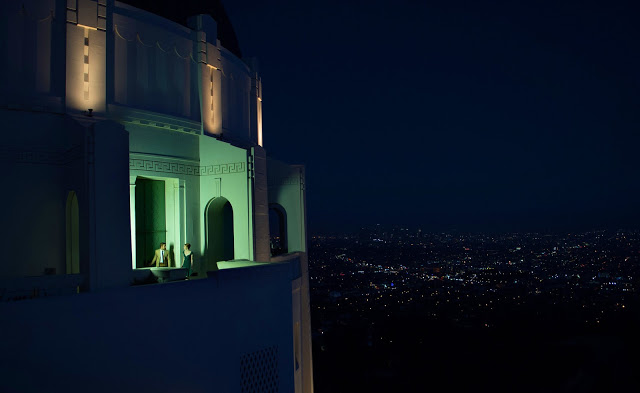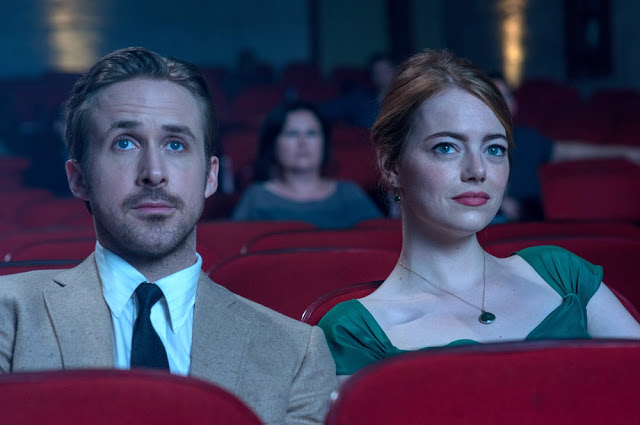The movie musical didn’t need to be resurrected, because it never died. It has become fashionable for misty-eyed critics to pine for the glory days—of Busby Berkeley and Bing Crosby, of Rogers & Astaire and Rodgers & Hammerstein—but the twenty-first century has featured more than its share of quality musicals, from Chicago to The Last Five Years to Moulin Rouge. Yet the continued vitality of the musical shouldn’t diminish the staggering triumph that is La La Land, the astonishing tour de force of song, dance, and joy from Damien Chazelle. To declare that this sweeping, soaring film has salvaged the musical from obscurity would be both inaccurate and reductive; La La Land is far too vibrant and versatile to be trivialized as the savior of a particular genre. All the same, it may well serve a broader critical function—simply uttering its title can now operate as a reflexive retort whenever anyone dares to bemoan the quality of modern movies. The musical may not be dead, but La La Land reaffirms that cinema itself is very much alive.
Of course, anyone doubting the medium’s endurance probably hasn’t seen Chazelle’s prior film, Whiplash. That brilliant drama chronicled the corrosive relationship between a virtuoso drummer and his ferocious conductor, a fascinating dynamic that revealed the dark underbelly of the pursuit of greatness. With La La Land, Chazelle has retained Whiplash‘s relentless energy, but he has swapped out its obsessive fury in favor of a grand romanticism. The director is undeniably enraptured with the musicals of yesteryear, in particular Jacques Demy’s classic The Umbrellas of Cherbourg, but his filmmaking is too vigorous and inspiring to be motivated purely by nostalgia. Instead, he has harnessed his considerable formal powers to tell a story of piercing emotional clarity, if one that also happens to pay heartfelt homage to Tinseltown’s rich history. His abiding love of old movies has allowed him to make a spectacular new one.
It takes some time for La La Land to establish its particular rhythm, or rather, it takes exactly three minutes and forty-eight seconds. That is the official length of the movie’s opening number, “Another Day of Sun,” a remarkable, gleefully outrageous display of musical gymnastics. Shot on a traffic-choked L.A. freeway and featuring more than a hundred dancers, it instantly establishes the sheer magnitude of the film’s ambition; Chazelle and his cinematographer, Linus Sandgren, capture everything in a single, flowing take, gliding from one car to another as brightly costumed extras sing, smile, leap, and tumble. It’s the kind of bravura introduction that demands a standing ovation even before the appearance of the opening title card.
This massive overture is also a sly bit of misdirection. With its theatrical scope and visual flair, La La Land feels downright enormous, but as a narrative, it’s beautifully intimate, centering on two wayward, wannabe artists who meet-uncute in the midst of that glorious traffic jam. The movie’s first act follows its heroes separately, efficiently establishing their hopes and frustrations with the majesty and misery of life in the City of Angels. Mia (Emma Stone) is an aspiring actress who pays the rent by working as a barista on the Warner Brothers studio lot; she’s growing disenchanted with the audition circuit, as she’s constantly being passed over in favor of taller, prettier women, all while scrapping to star in pitiful-sounding projects with loglines like, “Dangerous Minds meets The O.C.” (Sample dialogue: “No, Jamal—you be trippin’.”). Across town, Sebastian (Ryan Gosling) is a piano player and jazz aficionado who longs to open his own club, but seeing as the position of “Hoagy Carmichael enthusiast” doesn’t generate much income, he’s reduced to playing holiday carols at restaurants and gigging in cheesy ’80s cover bands.
It’s like they’re made for each other! But the romantic magic of La La Land goes far beyond writerly symmetry. The key to any love story is strong chemistry between the leads; Stone and Gosling have previously been paired in movies both good (Crazy Stupid Love) and bad (Gangster Squad), but here they deliver pitch-perfect performances that are exquisitely complementary. Mia and Sebastian’s courtship is founded as much on hostility as magnetism, and the actors revel in the comic timing of their characters’ snippy one-upmanship. It’s a delightfully rancorous rapport, and when the two share an accidental nighttime stroll in the Hollywood Hills, they disguise their growing attraction as mutual antipathy.
Of course, their rhythmic sparring is not entirely verbal—they also spend that evening singing and tap-dancing. A cynic might deem this a cheap trick designed to heighten their connection, but La La Land‘s boisterous tone leaves no room for cynicism. Let me be clear: As a musical, this movie is utterly magnificent. On the page, the songs by Justin Hurwitz are both buoyant and precise, with gorgeous melodies and graceful rhymes. But it is Chazelle’s execution that truly astounds. Aesthetically speaking, La La Land is as bold and expressive a picture as you are likely to see. The colors seem to pop off the screen, bursts of monochrome that intensify the movie’s vivid palette. The camera movements are mesmerizing, with Chazelle disfavoring rapid cutting and instead filming incredibly complex numbers in long, impossibly fluid shots. And the choreography by Mandy Moore is masterful, capturing the film’s vivacious spirit; when Mia and Sebastian suddenly embark on a literal flight of fancy in the L.A. planetarium, you will feel as though you’re floating right beside them.
Yet for all its operatic grandeur, La La Land can also be breathtakingly quiet, as when Mia turns one of her auditions into an elegiac tribute to a lost relative. “Here’s to the fools who dream,” she sings softly, her surroundings melting away as Chazelle slowly pushes in on Stone’s face, alight with longing and memory. It’s a scene of simple, startling power, and it speaks to the richness of the film’s emotions.
At its core, La La Land is about the giddy and painful process of finding and losing love, but it is also about art itself, which places it in a very precarious position. Any movie that so passionately reveres its forebears is liable to be guilty of revisionist history, of piously bowing its head to the past while smugly thumbing its nose at the present. La La Land seems destined to fall into that realm of condescension when Sebastian reunites with Keith (John Legend, nicely relaxed), a commercially successful pop star who fronts a band called The Messengers. Sebastian grudgingly accepts Keith’s offer of work, but he clearly views his new employer as a sellout, a betrayer of jazz’s true identity. And for a time, it appears that the movie agrees with him; certainly, its depiction of one of The Messengers’ concerts—complete with garish lighting, glitzy dancers, and a gaudy electronic keyboard—suggests an outfit that’s more concerned with money than music.
Yet La La Land deftly sidesteps this trap, fashioning Keith not as a vulgar hack but a thoughtful artist, one who may have refined his technique but hasn’t abandoned his principles. Recognizing Sebastian’s distaste for the music he’s being paid to play, Keith asks him, “How can you be a revolutionary when you’re such a traditionalist?” It’s a fair question—thankfully, Chazelle is both. With La La Land, he somehow manages to honor cinema’s golden age while simultaneously propelling the industry forward. Nowhere is this more evident than in the movie’s ending, a stunning, audacious sequence that wistfully encapsulates the film’s themes. It’s a finale that’s at once exhilarating and heartbreaking.
And really, the same goes for La La Land as a whole. Its critical plaudits will likely include some variation on the line, “They don’t make ’em like this anymore,” which is a falsehood on its face—they just did. But do not mistake this marvelous film for a mere throwback; it is far too vital, too present, to be a meager imitation of the past. So here’s to you, La La Land. Here’s to the movies that dream.
Jeremy Beck is the editor-in-chief of MovieManifesto. He watches more movies and television than he probably should.




